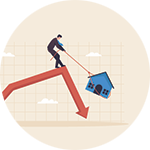Better Mortgage Rates on the Horizon - November 2024
- The base rate came down to 4.75% in The Bank of England's November meeting.
- Inflation increased to 2.3% due to the Winter fuel cap removal and Christmas overspending, so the base rate is unlikely to come down again before 2025.
- Mortgage lenders have been slow to lower their rates since the base rate fall; expect better deals to come into the market from January 2025.
- The current average 5-year fixed rate mortgage is 5.65% and the current average 2-year fixed rate mortgage is 5.34%.
- The lowest available 2-year fixed rate is 4.22% and the lowest available 5-year fixed rate mortgage is 4.14%.
- The housing market will, as usual, be flat over Christmas whilst the markets look to the New Year for better opportunities.
- The remortgage market is and will be, hit the most from all of this as prospective remortgagers need lower rates to go ahead.
- The average UK salary is at its highest, reaching £36,192. This means the average mortgage you could get on this salary (4.5x annual salary) is around £162,864 based on a good credit score.
Business tax hikes criticised but Chancellor hits back at naysayers
During their General Election campaign earlier this year, Labour put economic stability and growth at the top of the list. However, in the October budget announcement, a £22bn "black hole" needed to be filled meaning tax rises where businesses predominantly foot the bill.
Rain Newton-Smith, director general at The Confederation of British Industry openly criticised Chancellor Rachel Reeve's October budget where taxes increased by the largest amount since John Major's government in 1993.
The director general said "Too many businesses are having to compromise on their plans for growth" and "profits aren't just extra money for companies to stuff in a pillowcase. Profits are investment."
But Chancellor Rachel Reeves hit back noting that no business leaders offered a suitable alternative solution to the challenges Labour inherited from the previous Conservative government.
Reeves said "I have heard lots of responses to the government’s first budget but I have heard no alternatives," adding "We have asked businesses and the wealthiest to contribute more. I know those choices will have an impact. But I stand by those choices as the right choices for our country: investment to fix the NHS and rebuild Britain while ensuring working people don’t face higher taxes in their payslips."
Sources: Sky and The Guardian
Housing affordability is down, London particularly the worst-off
The recent decline in affordable housing starts in London is a significant concern. With an 88% drop from the previous year, only 3,100 affordable homes were started in Greater London between April 2023 and March 2024. A stark reminder of the growing housing crisis in the city.
In the boroughs of Harrow, Bexley, and Richmond-upon-Thames, a mere one affordable property was started during the entire year. This lack of affordable housing options exacerbates the challenges low-income individuals and families face in accessing decent and affordable housing in these areas.
A spokeswoman for London Councils remarked that housing conditions were "incredibly tough" to start building new, affordable housing in the capital city.
She said that "There are 287,000 potential new homes in London with planning permission, including 70,000 affordable homes, that have yet to be built," and "There are a lot of barriers to unlocking these sites – such as skyrocketing construction costs, and in recent years, a lack of capital funding and infrastructure."
The Mayor of London, Sadiq Khan, criticised local Conservatives within London for failing to keep pace on the affordable homes target.
He said "The Conservatives nationally have scrapped housing targets and failed on their affordable homes plans. Meanwhile, Tory town halls in the capital simply aren’t keeping pace in delivering the new homes we need, ripping away the ladder from young Londoners."
Sources: BBC News and City AM.

Will there be another base rate fall?
It's unlikely. With inflation increasing higher than expected this month from 1.7% to 2.3%, my money is on the base rate remaining at 4.75%.
Although many people hoped for a rapid decrease by the end of the year, the Bank of England has taken a cautious approach to keep markets steady.
The mortgage landscape seems like it will stabilise as we enter 2025, though, so we could see another base rate cut when the Monetary Policy Committee (MPC) meets again on the 6th of February 2025.
Another reduction in the base rate would be a welcome sight for prospective buyers and homeowners looking to remortgage, meaning that borrowers can plan their future with confidence.
While interest rates have risen in recent years, it's important to consider the broader picture. House prices are expected to continue their upward trajectory (Around 3% per year), so delaying a purchase in anticipation of significant rate drops may not be the most strategic move.
By buying sooner and locking in a mortgage now, you could secure your position in the market and potentially benefit from the house price rises. However, a predicated base rate of around 3.75% by the end of 2025 means that it might be worth the wait for some.
Will there be a UK recession in 2025/6?
Bank of England policymaker Alan Taylor has warned that the UK economy is at a growing risk of “a bumpy landing”.
"..where inflation undershoots, and goes below target in late 2026, and the economy moves into a weakened state for a sustained period, with output and employment below potential, leading to undue damage to economic activity."
Will mortgage rates go down in 2024?
In a recent Zoopla article, Nic Hopkirk suggests mortgage rates will stay at and around 4-4.5% for the rest of 2024 and the base rate will likely fall to 3.5% by the end of 2025.
We've seen the mortgage rate average staying higher than expected at around 5-5.5% but the lowest products on the market are hovering at around 4-4.5%.
Lowest July on record for property sales volume
England & Wales
Property sales volume fell by 27% year on year at 37,746 in July. While these figures will increase once the Land Registry data is updated, sales volumes continue to fall.
London 
London echoes the wider country, falling 28% year on year in July to 4,351, in the most recent data for registered properties released by the Land Registry. For more on London, read: London Housing Market Report.
Average house prices in London remained relatively stable at £529,903 for September 2024. An increase of 1% year on year.
Are UK house prices falling?
They aren't. In fact, they're likely to keep rising. The average house prices in England and Wales rose yet again year on year by 2% to £303,769 for September 2024 (the highest in September on record). Rightmove reports that the average new seller's asking price is £366,592, dropping by 1.4%. However, they forecast that in 2025, the average new seller's asking prices will rise by around 4%.
Surprisingly, the average house price in London fell by 1% year on year for September 2024 at £525,586.
Mortgage approval reports
Home buyers
Mortgage approvals for home buyers grew slightly in October 2024 to 68,303, up 29% from October 2023 and in line with what I'd expect for October pre-pandemic. The average in the last 10 years for October is 67,495.
Best rates for homebuyers with 5-10% deposits
The current average 5-year fixed rate mortgage is 5.65% and the current average 2-year fixed rate mortgage is 5.34%. However, the lowest available 2-year fixed rate is 4.22% and the lowest available 5-year fixed rate mortgage is 4.14%. Source: Rightmove.
If your current mortgage deal is about to end (in the next 3-6 months), you should start the remortgage process before the best rates disappear. You'll want to avoid being put on your lender's Standard Variable Rate (SVR) which is on average around 7.99%.
Remortgages
The remortgage growth YOY for October was similar to home buyers up 26%. October 2024 saw 31,390 remortgages approved, but still a way off from the 41,144 average over the past 10 years for the month.
Many homeowners cannot afford the high mortgage interest rates available now when they took mortgages out with rates at 1-2% a few years ago. This leaves some homeowners trapped in mortgages they're struggling to pay.
With the base rate fall in November and the potential for better mortgage rates in 2025, we could see a return to the market for floods of homeowners looking to remortgage. If not, numerous homeowners will be forced to sell.
How many new build properties are being built?
The average price of a new build in England and Wales is at its highest ever at £433,971 (July 2024), up 23% from July 2023. Purchasing a new build property will set you back at least £135,000 more than an average-priced home.
New Build prices remain high


Andrew Boast FMAAT
CEO of SAM Conveyancing
Following the recent UK budget and US presidential election, uncertainty surrounding inflation and the global economy has led to an increase in swap rates, the rates at which banks lend to each other. Economic conditions permitting, the Base Rate could potentially reach around 4% by Autumn 2025.
The base rate is unlikely to fall again by the end of 2024 due to Christmas overspending and the inflation increase. However, the decrease to 4.75% last month saw a healthy enough growth in the market, giving it a much-needed boost before the inevitable Christmas market slump.
The average price for a property in England and Wales is still high and at an eye-watering £303,769, whilst sales volume is 31% down year on year.
It remains to be seen how new second-home Stamp Duty Land Tax rules and the abolition of the first-time buyer relief post-March 2025 could affect the market, whether it boosts the sales volume for domestic first-time buyers scrambling to get their foot on the property ladder, or drives away ambitious overseas investors.
Sources: Latest data from - Gov.UK, Bank of England, UK House Price Index, ONS and Property Mark (NAEA).

Without Killing Anyone
This book could be the difference between every mover’s dream, buying and moving into your new home stress free, or, stress, missed deadlines, legal disasters, building defects, and possibly the collapse of the whole transaction. (Costing you a small fortune, a head full of grey hairs, and, driving you to threaten the life of your solicitor, lender, co-owners, family, partner, or some combination of all five).
With more than two decades’ experience in the conveyancing sector and over 50,000 successful client moves under his belt, Andrew shares insider tips and advice to empower you as a buyer, giving you the tools to make the best decisions for your circumstances and ease the chaos.
Available on Amazon | Kindle | Paperback












